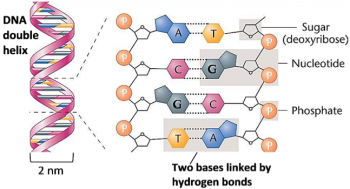Serendip is an independent site partnering with faculty at multiple colleges and universities around the world. Happy exploring!
DNA

In this hands-on, minds-on activity, students extract DNA from Archaea or from their cheek cells.
In addition, students learn or review key concepts about the structure, function, and replication of DNA. For example, students learn that the genes in DNA give the instructions to make proteins, which influence our characteristics.
They also learn how the double helix structure of DNA and the base-pairing rules provide the basis for DNA replication.
This activity includes multiple analysis and discussion questions and hands-on or online modeling of DNA replication. (NGSS)
Download Student Handout Archaea: PDF format or Word format
Download Teacher Preparation Notes Archaea: PDF format or Word format
Download Student Handout Cheek Cells: PDF format or Word format
Download Teacher Preparation Notes Cheek Cells: PDF format or Word format
The Teacher Preparation Notes provide instructional suggestions and background information and explain how this activity is aligned with the Next Generation Science Standards.
We invite comments on this Hands-On Activity and the accompanying Teacher Preparation Notes, including suggestions for other teachers who are planning to use the activity, additional resources, any questions you have related to the activity, or a brief description of any problem you might have encountered. If you would prefer to send your comments or questions in a private message, please write Ingrid Waldron at iwaldron@sas.upenn.edu.











Comments
2023 revision
The revised Student Handout for the Haloferax version begins with the driving question and a page that introduces students to DNA and its functions in order to motivate interest in the extraction of DNA that follows. In addition, both versions of the Student Handout have better figures, and the questions are more focused on the essential points. The Teacher Preparation Notes have been revised to improve clarity and include additional information.
Ingrid
2020 revision
The Teacher Preparation Notes for the Haloferax version of this activity provide updated information about how to obtain Haloferax. The cheek cell version of this activity includes an explanation of how soap breaks down cell membranes as one step in extracting DNA from cheek cells; the Teacher Preparation Notes now include suggested resources to teach about how handwashing with soap can help to prevent the spread of the coronavirus by breaking down the viral envelope.
cheek cell protocol comparisons
I was having trouble getting a nice amount of DNA using the protocol for cheek cells. I had used the Carolina kit in the past, and thought that had worked better, but didn't want to spend the money. Here's a ppt with the biochemistry involved and a comparison of results using different materials, for teachers: https://www.ox.ac.uk/sites/files/.../Biochemistry%20workshop%20presentation.pdf
correct link to presentation
I see that the presentation is here:
https://www.ox.ac.uk/sites/files/oxford/field/field_document/Biochemistry%20workshop%20presentation.pdf
DNA Extraction Methods
Thank you both for identifying this link, which provides much useful information about how to extract DNA from cheek cells.
Ingrid
2015 revision
The questions in the Student Handout have been streamlined to improve focus on the key points. The Teacher Preparation Notes provide improved instructions for the hands-on replication simulation and additional instructional suggestions.
2014 revisions
The Student Handout has substantially revised questions to improve student learning of the most important concepts related to the structure, function and replication of DNA. In addition, the revised Student Handout incorporates hands-on modeling of DNA replication. The Teacher Preparation Notes have been revised to accommodate these changes, to indicate alignment with the Next Generation Science Standards, and to suggest follow-up activities.
DNA extraction
I completed this lab, but modified the protocol so that students sampled DNA from cheek cells, wheat germ and various types of fruit ( we used bananas and strawberries). Students worked in group of 3 or 4, and each student was assigned a different source for DNA. The students then compared their results.
Extracting DNA from Different Sources
This is an interesting approach. I am curious what the students found when they compared the DNA extracted from different sources. How did you interpret what they observed?
October 2011 revision
The revisions of the Student Handout have clarified and improved the questions for students to answer as they learn about DNA structure and replication, and also incorporated improved figures. The revised Teacher Preparation Notes have incorporated suggestions for extracting DNA from split peas (as an alternative to extracting DNA from cheek cells), clarified the teaching points, and added suggestions for linking this activity on DNA structure and replication to learning activities concerning DNA function.
Suppose that DNA did not have
Suppose that DNA did not have a double helix structure, and instead DNA was single-stranded. Imagine that a cell with this single-stranded DNA was ready to begin cell division. How could a cell replicate single-stranded DNA so the daughter cells could receive an exact copy of the genes present in the original cell? Use your answer to explain why it is an advantage for DNA to have a double helix structure with paired nucleotides.
Post new comment